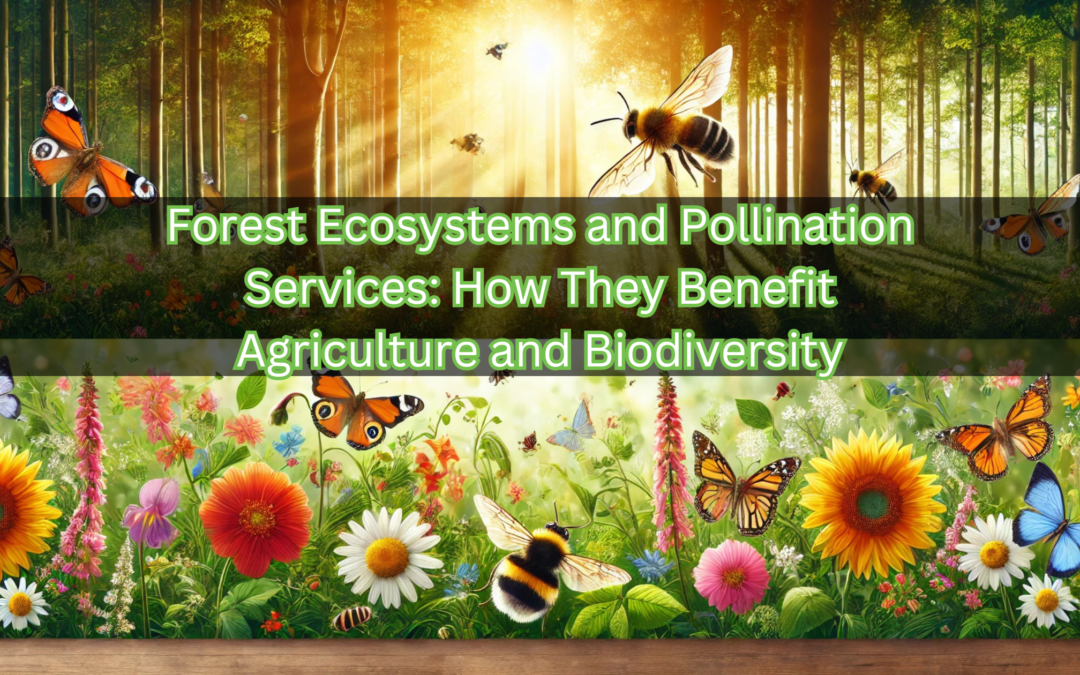Pollination is a vital process that directly affects agriculture and biodiversity. It’s the movement of pollen from one flower to another, leading to fertilization and the production of seeds and fruits. Without pollination, many of the plants we rely on for food, and those that support wildlife, wouldn’t be able to reproduce. But what role do forests play in all of this? Forest ecosystems are key to supporting the pollinators that make it all possible.
In this article, we’ll explore how forest ecosystems contribute to pollination services, how they benefit agriculture, and why protecting these ecosystems is critical for biodiversity.
Supporting Pollinator Species in Forest Ecosystems
Forests provide homes for a wide variety of pollinators. Bees, butterflies, birds, bats, and other insects rely on forests for food, shelter, and breeding spaces. The diverse range of flowering plants in forests, particularly tropical ones, offer a consistent supply of nectar and pollen. This ensures that pollinators have what they need to survive and reproduce.
For example, bees play a huge role in pollination, and they thrive in forest environments where there’s a steady variety of flowers. In return, these pollinators help forests flourish by aiding plant reproduction, creating a robust and interconnected ecosystem.
Benefits of Forest Pollinators for Agriculture
The link between forests and agriculture is stronger than you might think. Many crops, like fruits, vegetables, nuts, and seeds, depend on animal pollinators to ensure successful fertilization. Forest ecosystems, especially those located near farms, provide a steady supply of these essential pollinators.
A great example is coffee plantations near forests. Studies have shown that these farms experience higher rates of pollination and produce more coffee beans than those farther away from forested areas. This direct benefit to agriculture highlights the importance of keeping forest ecosystems healthy to boost crop yields and ensure food security.

Enhancing Biodiversity Through Pollination in Forest Ecosystems
Pollination doesn’t just support agriculture—it’s also crucial for maintaining biodiversity. Forest ecosystems help preserve plant diversity by enabling the reproduction of plants through pollination. A wide variety of plant species creates food and shelter for countless animal species, contributing to a balanced and resilient ecosystem.
Forests with diverse plant life also help ensure that pollinators, like bees and butterflies, have access to food throughout the year. This diversity boosts the chances of survival and reproduction for pollinators, further supporting the ecological balance.
The Bigger Picture: Ecosystem Services and Climate Regulation
Pollination is just one of the many ecosystem services forests provide. Forests also help regulate the climate, preserve soil, manage water systems and store carbon. These ecosystem services help create stable environments that support both biodiversity and sustainable agricultural practices. By protecting forest ecosystems, we’re also helping to combat climate change and ensure the long-term health of our planet.
How Can We Protect Pollination Services?
The health of pollination services depends on the conservation of forest ecosystems and the adoption of sustainable land-use practices. Here are a few steps we can take to protect these critical systems:
- Conserve natural ecosystems: Protecting and restoring damaged forest areas is key to maintaining pollinator habitats. Learn more from The Nature Conservancy.
- Promote agroforestry: Combining agriculture and forest systems helps preserve pollinator habitats while supporting farming activities. Explore solutions at Agroforestry Systems.
- Create ecological corridors: These can help connect fragmented habitats and support the migration and survival of pollinators. Check out more on Ecological Corridor Guidelines.
- Encourage organic farming: Reducing pesticide use is crucial for the health of pollinators. Organic farming practices protect pollinators from harmful chemicals, ensuring they continue to thrive and support agriculture. Learn about organic farming practices.
Take Action to Protect Forest Ecosystems and Pollination Services
Forests play a critical role in supporting pollination services, which in turn sustain agriculture and biodiversity. By taking steps to protect forests, we not only support the health of pollinators but also contribute to the overall sustainability of our food systems and the planet.
Make a difference in the world. Explore more at the World Resources Institute and The Pollinator Partnership. Let’s work together to protect our forests, support pollinators, and build a more sustainable future for all.
Want to learn more about forest ecosystems and their role in agriculture and biodiversity? Check out the resources on EAT Community,
Related Articles and Resources:
- Preserving Forest Biodiversity for a Sustainable Future
- Bees, birds, butterflies, bats: NSF helping keep pollinators, bioeconomy healthy
- How Forest Ecosystems Help Regulate Climate Patterns
- Why the Next 3 Months Are Critical for People, Nature and Climate
- Bee Friendly Farming
- How Animals Help Us To Save The Planet – Useful Animals For The Nature
- Agroforestry
- IFOAM – Organics International
- IUCN Guidelines for Ecological Corridors – EUROPARC Federation




Hey people!!!!!
Good mood and good luck to everyone!!!!!